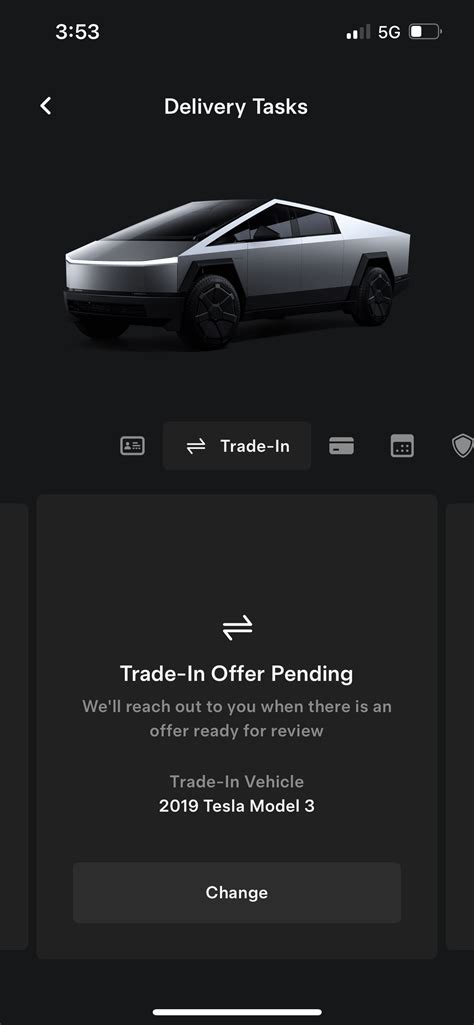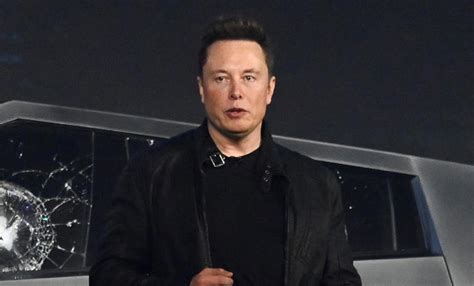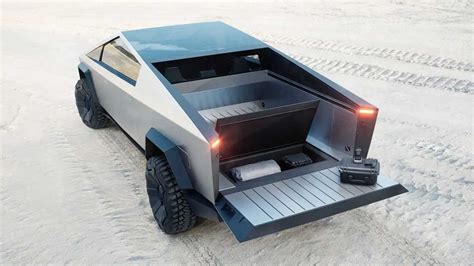
Tesla is now accepting Cybertruck trade-ins, providing a first glimpse into the vehicle’s real-world depreciation. Early estimates suggest trade-in values are lower than some owners anticipated, sparking discussions about the Cybertruck’s long-term value retention.
Tesla has officially launched its Cybertruck trade-in program, allowing owners to exchange their vehicles for other Tesla models or potentially future Tesla products. This move provides the first concrete data points on the Cybertruck’s depreciation, a topic of considerable interest given the vehicle’s high initial price and unconventional design. While specific trade-in values vary based on configuration, mileage, and condition, initial reports from owners suggest that the offers are below many expectations.
According to a report by Yahoo Finance, this development arrives several months following the initial deliveries of the stainless-steel clad truck. The Cybertruck, known for its polarizing design and substantial price tag, has generated considerable buzz since its unveiling. Now, owners considering an upgrade or a shift to a different vehicle are facing the realities of the used-car market.
The discrepancy between anticipated and actual trade-in values highlights the complexities of valuing a relatively new and unique vehicle like the Cybertruck. Factors influencing the depreciation rate could include production ramp-up challenges, which affect supply; the long-term demand for such a niche vehicle; and potential maintenance costs associated with its distinctive features.
“The Cybertruck is such a unique vehicle, it’s hard to predict exactly how it will hold its value,” says automotive analyst Jessica Caldwell. “The trade-in values will depend on a number of factors, including the overall demand for used Cybertrucks and the condition of the individual vehicle.”
While Tesla has not released official statements regarding the average depreciation rate of the Cybertruck, anecdotal evidence from online forums and social media groups indicates a mixed bag of experiences. Some owners report receiving trade-in offers that align with their expectations, while others express disappointment.
One Cybertruck owner, who requested anonymity, shared that they received a trade-in offer significantly lower than the MSRP they paid just a few months prior. “I knew there would be some depreciation, but the offer was much lower than I expected,” they said. “It definitely makes me think twice about trading it in.”
Another owner, however, reported a more positive experience. “I was pleasantly surprised with the trade-in value I received,” they said. “It was in line with what I was expecting, considering the mileage and condition of my truck.”
The varying experiences underscore the challenge of accurately assessing the Cybertruck’s depreciation at this early stage. As more data becomes available through Tesla’s trade-in program and third-party valuation services, a clearer picture of the vehicle’s long-term value retention will emerge.
Factors Influencing Cybertruck Depreciation:
Several factors are likely to influence the Cybertruck’s depreciation rate. These include:
- Production Volume: Tesla’s ability to ramp up Cybertruck production will directly impact supply and, consequently, resale values. If production remains constrained, demand for used Cybertrucks could remain high, potentially mitigating depreciation. Conversely, a rapid increase in production could flood the market, driving down used prices. Tesla has faced significant production hurdles and delays, which may contribute to uncertainty in the used market.
- Demand and Market Acceptance: The Cybertruck’s unconventional design and unique features appeal to a specific segment of the market. Long-term demand will depend on whether the vehicle maintains its novelty and continues to attract buyers. If the initial hype fades, demand for used Cybertrucks could decline, leading to higher depreciation.
- Battery Degradation: As with all electric vehicles, battery degradation is a key factor influencing long-term value. The Cybertruck’s battery performance over time will impact its range and overall usability, affecting its desirability in the used market. Tesla’s battery technology is considered relatively robust, but real-world performance under various driving conditions will ultimately determine the extent of degradation.
- Maintenance and Repair Costs: The Cybertruck’s stainless-steel exterior and unique construction could present challenges for maintenance and repair. Specialized tools and expertise may be required, potentially increasing costs and impacting resale values. Reports of rust and corrosion on the stainless steel body may raise concerns among potential buyers.
- Technological Advancements: The rapid pace of innovation in the electric vehicle industry could also impact the Cybertruck’s value. Newer EVs with superior range, performance, or features could make the Cybertruck less appealing to potential buyers, accelerating depreciation.
- Government Incentives and Regulations: Changes in government incentives for electric vehicles and regulations related to vehicle emissions could also affect the Cybertruck’s resale value. Reduced incentives or stricter regulations could diminish demand for EVs in general, impacting the Cybertruck’s market value.
Expert Opinions and Analysis:
Automotive industry experts offer varying perspectives on the Cybertruck’s depreciation. Some analysts believe that the vehicle’s unique design and limited production will help it retain value, while others are more cautious.
“The Cybertruck is unlike anything else on the road, and that could help it hold its value better than other vehicles,” says Karl Brauer, an automotive analyst at iSeeCars.com. “Its limited production and high demand could keep used prices relatively strong.”
However, other experts caution that the Cybertruck’s unconventional design and potential maintenance challenges could lead to higher depreciation.
“The Cybertruck’s stainless-steel exterior and unique construction could present challenges for maintenance and repair, which could negatively impact its resale value,” says Ivan Drury, director of insights at Edmunds. “Potential buyers may be hesitant to purchase a used Cybertruck if they are concerned about the cost of repairs.”
The market for used Cybertrucks is still nascent, and it will take time for a clear picture of the vehicle’s depreciation to emerge. However, the initial trade-in data provides valuable insights into the factors that are likely to influence its long-term value.
Tesla’s Trade-In Process:
Tesla’s trade-in program allows owners to receive an estimated value for their current vehicle, which can then be applied towards the purchase of a new Tesla. The process typically involves submitting information about the vehicle’s condition, mileage, and features through Tesla’s website or mobile app. Tesla then provides an estimated trade-in value, which is subject to inspection.
Once the trade-in is approved, the owner can apply the value towards the purchase of a new Tesla. Tesla handles the paperwork and logistics of the trade-in, making the process relatively seamless for the owner.
Implications for Cybertruck Owners:
The initial trade-in data has important implications for Cybertruck owners. Owners who are considering trading in their vehicle should be prepared for potentially lower-than-expected offers. It is advisable to obtain multiple appraisals from different sources, including Tesla and third-party valuation services, to get a more accurate assessment of the vehicle’s market value.
Owners should also carefully consider the factors that could influence the Cybertruck’s depreciation, such as production volume, demand, battery degradation, and maintenance costs. By understanding these factors, owners can make more informed decisions about whether to keep or trade in their Cybertruck.
Potential Future Scenarios:
The future value of the Cybertruck is subject to a range of potential scenarios. If Tesla successfully ramps up production and demand remains strong, the Cybertruck could retain its value relatively well. However, if production challenges persist or demand wanes, depreciation could accelerate.
Technological advancements in the electric vehicle industry could also impact the Cybertruck’s value. If newer EVs with superior features and performance emerge, the Cybertruck could become less appealing to potential buyers, leading to higher depreciation.
Ultimately, the Cybertruck’s long-term value will depend on a complex interplay of factors, including production, demand, technology, and market conditions. Owners and potential buyers should carefully monitor these factors to make informed decisions about the vehicle’s future value.
The Cybertruck’s Impact on the Electric Vehicle Market:
The Cybertruck’s arrival has undeniably shaken up the electric vehicle market. Its radical design, robust performance capabilities, and strong branding have captured the attention of consumers and industry observers alike. While the initial trade-in data offers insights into depreciation, the Cybertruck’s broader impact on the EV landscape is worth considering.
- Increased Competition: The Cybertruck has intensified competition in the electric truck segment, pushing other manufacturers to accelerate their development of electric pickups. The Ford F-150 Lightning, Rivian R1T, and other electric trucks are now vying for market share, offering consumers a wider range of options.
- Innovation and Design: The Cybertruck’s unconventional design has challenged traditional automotive aesthetics and inspired other manufacturers to explore new design concepts. While not all automakers will adopt the Cybertruck’s angular, stainless-steel approach, the vehicle has demonstrated the potential for innovation in EV design.
- Performance and Capabilities: The Cybertruck’s impressive performance capabilities, including its towing capacity and off-road prowess, have raised the bar for electric trucks. Other manufacturers are now striving to match or exceed the Cybertruck’s performance specifications.
- Brand Image and Perception: The Cybertruck has reinforced Tesla’s image as a disruptive and innovative company. The vehicle’s bold design and cutting-edge technology have solidified Tesla’s position as a leader in the electric vehicle market. However, the design continues to divide opinion and the long-term impact of the design on Tesla’s overall brand remains to be seen.
- Market Expansion: The Cybertruck has the potential to expand the electric vehicle market by attracting buyers who may not have previously considered an EV. Its truck-like capabilities and rugged design could appeal to consumers who prioritize utility and off-road performance.
The Cybertruck’s influence on the electric vehicle market is likely to continue to evolve as production ramps up and more vehicles reach consumers. The vehicle’s long-term impact will depend on its ability to maintain its appeal and meet the needs of its target market.
Challenges and Controversies:
The Cybertruck’s journey has not been without its challenges and controversies. From production delays to design criticisms, the vehicle has faced its share of obstacles.
- Production Delays: Tesla has encountered significant production delays with the Cybertruck, pushing back the initial delivery timeline. These delays have frustrated some potential buyers and raised questions about Tesla’s ability to meet demand.
- Design Criticisms: The Cybertruck’s unconventional design has been met with both praise and criticism. Some find the vehicle’s angular, stainless-steel exterior to be futuristic and appealing, while others consider it to be uninspired and unattractive.
- Build Quality Concerns: Some early Cybertruck owners have reported issues with build quality, including panel gaps, misaligned components, and other imperfections. These issues have raised concerns about Tesla’s quality control processes.
- Rust and Corrosion: Reports of rust and corrosion on the Cybertruck’s stainless-steel body have surfaced, raising questions about the vehicle’s durability and resistance to the elements. Tesla has acknowledged the issue and is reportedly working on solutions.
- Pricing and Affordability: The Cybertruck’s high price tag has made it inaccessible to many potential buyers. The vehicle’s base price is significantly higher than other electric trucks, limiting its appeal to a niche market.
- Safety Concerns: The Cybertruck’s rigid stainless-steel body has raised concerns about its crashworthiness and potential safety risks. Some experts argue that the vehicle’s lack of crumple zones could increase the risk of injury in a collision.
Tesla is addressing these challenges and controversies as production ramps up and more vehicles are delivered. The company’s ability to overcome these obstacles will be critical to the Cybertruck’s long-term success.
FAQ About Cybertruck Trade-Ins and Depreciation:
Q1: How does the Cybertruck’s depreciation compare to other electric vehicles?
A1: It’s still too early to definitively compare the Cybertruck’s depreciation to other EVs. However, given its unique design, limited production, and potential maintenance challenges, its depreciation rate could differ significantly. Some analysts predict that its limited production will help it retain value, while others are more cautious due to potential maintenance costs and the polarizing design. Ongoing data collection through Tesla’s trade-in program and third-party valuation services will provide a clearer picture over time. Expert Jessica Caldwell notes the challenge in predicting the value of such a unique vehicle, underscoring the need for more data.
Q2: What factors should I consider when trading in my Cybertruck?
A2: Key factors to consider include the vehicle’s condition, mileage, configuration, and current market demand. Obtain multiple appraisals from different sources, including Tesla and third-party valuation services, to get an accurate assessment of its market value. Also, be aware of potential factors influencing depreciation, such as production volume, battery degradation, and maintenance costs. Keep in mind that demand for unique vehicles like the Cybertruck can fluctuate, affecting trade-in values.
Q3: Are there any specific maintenance considerations that could affect the Cybertruck’s value?
A3: Yes. The Cybertruck’s stainless-steel exterior and unique construction could present maintenance challenges. Specialized tools and expertise may be required for repairs, potentially increasing costs. Reports of rust and corrosion on the stainless-steel body may also raise concerns among potential buyers and impact resale values. Addressing these issues promptly and maintaining detailed maintenance records can help preserve the vehicle’s value.
Q4: How does Tesla’s trade-in program work for the Cybertruck?
A4: Tesla’s trade-in program allows owners to receive an estimated value for their Cybertruck, which can be applied towards the purchase of a new Tesla. The process involves submitting information about the vehicle’s condition, mileage, and features through Tesla’s website or mobile app. Tesla then provides an estimated trade-in value, subject to inspection. Upon approval, the value can be used towards a new Tesla purchase, with Tesla handling the paperwork and logistics. This process provides owners with a convenient way to upgrade or switch to another Tesla model.
Q5: Will the Cybertruck’s value be affected by future technological advancements in electric vehicles?
A5: Yes. The rapid pace of innovation in the electric vehicle industry could impact the Cybertruck’s value. Newer EVs with superior range, performance, or features could make the Cybertruck less appealing to potential buyers, accelerating depreciation. Staying informed about the latest advancements and how they compare to the Cybertruck’s capabilities can help owners anticipate potential impacts on its value.









